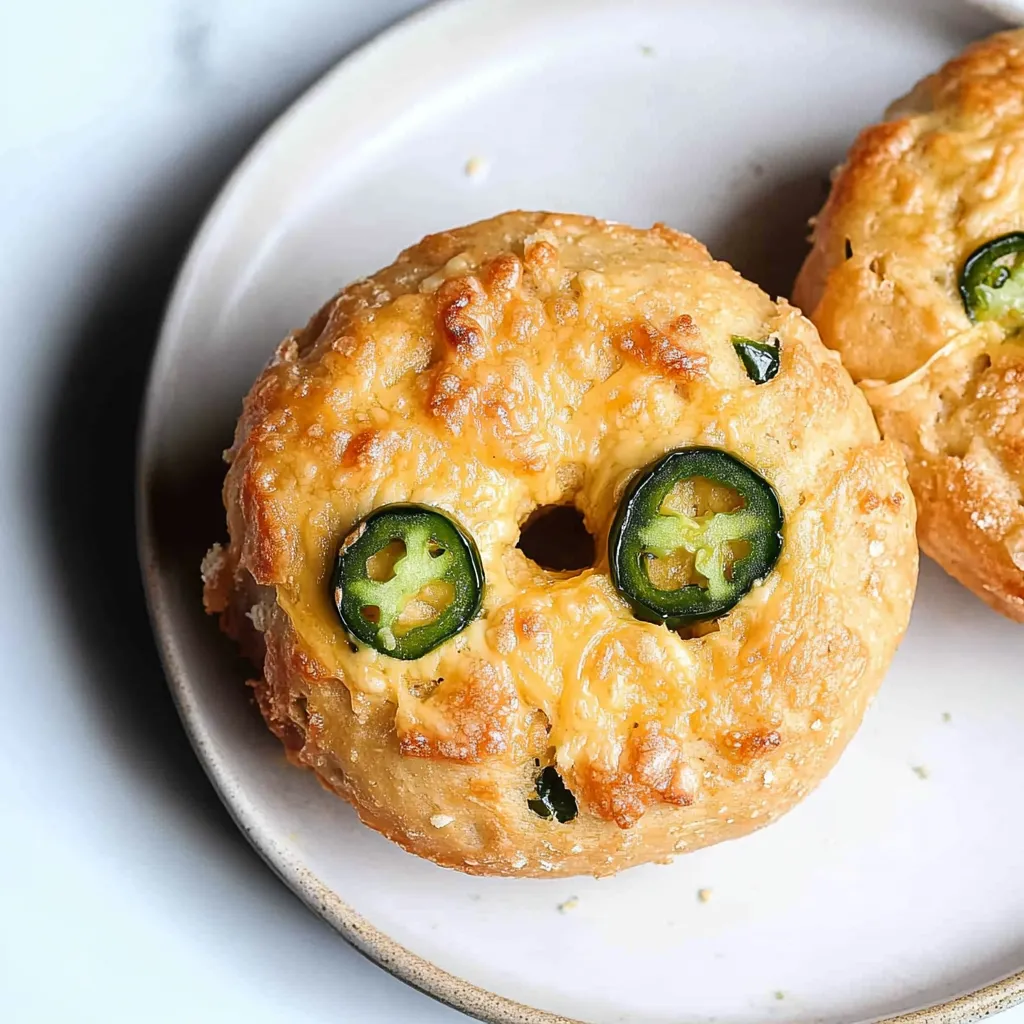 Pin it
Pin it
These jalapeño cheddar bagels pack incredible flavor throughout every single bite with fresh jalapeños grated right into the dough and sharp cheddar cheese mixed in for rich, tangy depth. The technique of infusing the bagel water with grated jalapeños creates beautiful color and distributes spicy heat evenly, while the traditional boiling process ensures that authentic chewy texture and shiny crust that makes real bagels so special. Unlike store-bought bagels with artificial flavoring or sparse toppings, these homemade versions deliver bold, fresh flavors from the inside out with a gorgeous cheese-crusted exterior that's absolutely irresistible.
I started making these bagels when my local bakery stopped carrying anything with real heat, and I was craving something with genuine spice and cheese flavors. The first batch I made exceeded all my expectations - the combination of the spicy jalapeño heat with the rich, melted cheddar created exactly the kind of bold breakfast I'd been missing, and now these have become my signature weekend baking project.
Essential Ingredients and Selection Tips
- Fresh jalapeños: Choose firm peppers with glossy skin and no soft spots; you'll need about 4-5 large or 8-10 small peppers for one batch
- Medium cheddar cheese: Block cheese that you grate yourself provides better melting and flavor than pre-shredded; medium cheddar balances sharpness without overwhelming
- High-protein flour: King Arthur all-purpose or bread flour creates better structure; regular all-purpose flour can work but may produce less chewy results
- Instant yeast: Also called rapid-rise yeast, this requires no proofing; if using active dry yeast, increase amount to 9 grams and expect longer rise times
- Diamond Crystal kosher salt: This brand is less salty than others; if using different salt, reduce amount by half to avoid over-salting
- Fresh eggs: Room temperature eggs create smoother egg wash; the jalapeño-infused egg wash helps toppings adhere and adds extra heat
The secret to perfect jalapeño distribution is grating them finely enough to avoid large chunks while wearing gloves to protect your hands from the capsaicin oils that can linger for days.
Detailed Step-by-Step Instructions
- Step 1: Prepare jalapeños safely:
- Put on disposable gloves before handling any peppers - this is absolutely crucial as capsaicin oils are nearly impossible to remove from skin. Using a fine microplane or paddle grater, grate the jalapeños including seeds for heat or removing seeds for milder flavor, stopping when about an inch of pepper remains to protect your fingers.
- Step 2: Create jalapeño water:
- Mix the grated jalapeños with lukewarm water (around 100°F) in a measuring cup and set aside. This bright green mixture will become the liquid base for your dough and ensures even distribution of jalapeño flavor throughout every bagel.
- Step 3: Combine dry ingredients:
- In your stand mixer bowl, whisk together the flour, salt, sugar, and instant yeast, keeping the salt and yeast separated as much as possible since direct contact can inhibit yeast activity. The flour provides structure, while salt controls yeast activity and enhances flavor.
- Step 4: Add cheese properly:
- Grate the cheddar cheese using the large holes of a box grater to create short strands rather than long ones. Toss the grated cheese with the flour mixture until every strand is coated - this prevents clumping and ensures even distribution throughout the dough.
- Step 5: Form the initial dough:
- Make a well in the center of the dry ingredients and pour the jalapeño water mixture into the middle. Using a spatula or gloved hands, mix everything together just until the liquid is absorbed - the pepper pieces slow absorption, so be patient during this stage.
- Step 6: Knead to proper texture:
- Attach the dough hook and mix on low-medium speed until a rough ball forms, about 2-3 minutes. Increase to medium speed and knead for 3-5 minutes until the dough becomes smooth, slightly tacky, and elastic - it may look less smooth than regular bagel dough due to the pepper pieces, but should feel smooth to touch.
- Step 7: First rise:
- Shape the dough into a ball, place in a lightly greased bowl, cover, and let rise for about 1 hour until nearly doubled. The dough is ready when a finger pressed into it leaves an indentation that springs back slowly.
- Step 8: Rest and prepare for shaping:
- Gently deflate the risen dough and let it rest covered for 10 minutes - this relaxation period makes shaping much easier and prevents the dough from fighting back when you try to form bagels.
- Step 9: Shape individual bagels:
- Divide the dough into 8 equal portions using a scale for precision. Shape each piece into a tight ball by flattening slightly, tucking edges under, and rolling under cupped hands until smooth. Let rest 10-15 minutes covered with damp paper towels.
- Step 10: Create bagel holes:
- Dust hands with flour and poke your thumb through the bottom seam of each dough ball. Insert your other thumb and gently stretch while rotating until the hole is at least twice the width of the bagel sides - the hole will shrink during boiling and baking, so make it larger than you think necessary.
- Step 11: Boil for authentic texture:
- Bring a large pot of water to a rolling boil and carefully add 2-3 bagels at a time. Boil for 1 minute per side (up to 2 minutes for extra chewiness), then remove with a slotted spoon or wire spider to a parchment-lined baking sheet.
- Step 12: Apply finishing touches:
- Brush each boiled bagel with egg wash mixed with grated jalapeño, then top with thin jalapeño slices and generous amounts of grated cheddar cheese. Don't be shy with the cheese - it protects the pepper slices and creates that beautiful golden crust.
- Step 13: Bake to golden perfection:
- Bake in a preheated 425°F oven for 20-25 minutes until the bagels are golden brown and the cheese is bubbly and slightly caramelized. The internal temperature should reach 200°F for fully baked bagels.
 Pin it
Pin it
The most critical techniques are wearing gloves throughout pepper handling, creating properly sized holes that won't disappear during baking, and not skipping the boiling step which is essential for authentic bagel texture.
This recipe has become my favorite weekend project because it proves that homemade doesn't have to mean settling for less flavor - in fact, these bagels deliver so much more heat and cheese flavor than anything I've ever bought. My husband, who usually grabs whatever's quickest for breakfast, now specifically requests these on Sunday mornings.
Understanding Bagel Science and Texture Development
Authentic bagel texture comes from the unique combination of low-hydration dough and the boiling process that gelatinizes surface starches. The relatively small amount of water creates a dense, chewy interior, while boiling forms a skin that becomes the characteristic shiny, leathery crust when baked. The addition of jalapeños and cheese affects hydration levels, which is why the recipe calls for careful monitoring of dough consistency. The pepper pieces add moisture while the cheese can absorb it, creating a balance that requires attention during mixing.
Capsaicin Handling and Heat Management
Capsaicin, the compound that makes peppers hot, is oil-based and extremely difficult to remove from skin once it penetrates. This is why gloves are absolutely essential throughout the process. The heat level can be controlled by including or removing seeds and ribs, which contain the highest concentrations of capsaicin. Grating distributes the heat evenly rather than creating hot spots, while the cooking process mellows the intensity slightly without eliminating the characteristic jalapeño flavor.
Cheese Integration and Melting Properties
Incorporating cheese into bread dough requires understanding how different moisture levels affect both texture and flavor. Coating cheese strands with flour prevents clumping and helps distribute them evenly throughout the dough. Medium cheddar provides the ideal balance of flavor and melting properties - sharper cheeses can become oily when heated, while milder cheeses may not provide enough flavor impact. The cheese on top creates a protective layer for the jalapeño slices while adding visual appeal and extra richness.
Yeast Activity and Fermentation Control
The presence of jalapeños and cheese affects yeast behavior differently than plain dough. The peppers add natural sugars that can feed yeast, while salt levels need careful balance to control fermentation without inhibiting it. The lower hydration typical of bagel dough slows yeast activity, which is why rise times are longer than for high-hydration breads. Temperature control becomes even more important with these additions, as the dough may behave differently in various kitchen environments.
Storage and Freshness Considerations
The addition of cheese and peppers affects storage life compared to plain bagels. The dairy content makes these more perishable, requiring consumption within a few days at room temperature. Refrigeration is not recommended as it accelerates staling, while freezing works well if bagels are sliced almost completely through first. The cheese and pepper toppings can become soggy if stored improperly, making paper bag storage with moisture absorption essential for maintaining texture.
These jalapeño cheddar bagels have taught me that sometimes the most satisfying baking projects are the ones that require patience and attention to detail rather than just throwing ingredients together. Every time I make them, I'm reminded that understanding the science behind techniques like proper fermentation and boiling creates results that simply cannot be achieved through shortcuts, making the extra effort completely worthwhile.
Frequently Asked Questions
- → Can I make these bagels less spicy?
- Yes, remove all the jalapeño seeds when grating and use fewer jalapeños. You can also substitute mild peppers like poblanos.
- → How long do these bagels stay fresh?
- Store at room temperature for up to 3 days in a paper bag or airtight container. Freeze for longer storage up to 3 months.
- → Can I use a different type of cheese?
- Sharp cheddar works best, but you can try pepper jack, gouda, or swiss. Avoid soft cheeses as they don't grate well into the dough.
- → Do I need special flour for bagels?
- All-purpose flour works fine. King Arthur flour is recommended for its higher protein content, or use bread flour for chewier results.
- → Why do bagels need to be boiled before baking?
- Boiling creates the signature chewy texture and shiny crust that makes bagels different from regular bread rolls.
- → Can I skip the stand mixer?
- You can knead by hand, but it will take 8-10 minutes of vigorous kneading to develop the gluten properly for chewy bagels.
